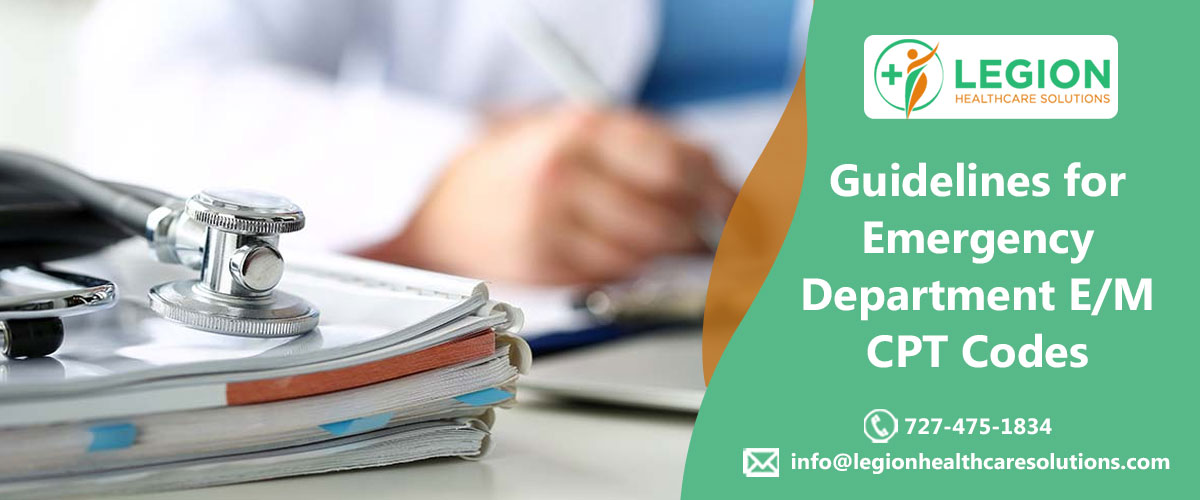
Guidelines for Emergency Department E/M CPT Codes
Any physician seeing a patient registered in the emergency department may use Emergency Department E/M CPT codes i.e., 99281 – 99285. It is not required that the physician be assigned to the emergency department. The ED codes require the level of Medical Decision Making (MDM) to be met and documented for the level of service selected. Note that, time is not a descriptive component for the emergency department levels of E/M services because emergency department services are typically provided on a variable intensity basis, often involving multiple encounters with several patients over an extended period of time.
Guidelines for Emergency Department E/M CPT Codes
- Emergency department coding is not appropriate if the site of service is an office or outpatient setting or any sight of service other than an emergency department. The emergency department codes should only be used if the patient is seen in the emergency department and the services described by the HCPCS code definition are provided. The emergency department is defined as an organized hospital-based facility for the provision of unscheduled or episodic services to patients who present for immediate medical attention.
- Services in the emergency department may not be emergencies. However the codes (99281 – 99288) are payable if the described services are provided. However, if the physician asks the patient to meet him or her in the emergency department as an alternative to the physician’s office and the patient is not registered as a patient in the emergency department, the physician should bill the appropriate office/outpatient visit codes. Normally a lower level emergency department code would be reported for a nonemergency condition.
- Emergency department visit provided on the same day as a comprehensive nursing facility assessment are not paid. Payment for evaluation and management services on the same date provided in sites other than the nursing facility are included in the payment for initial nursing facility care when performed on the same date as the nursing facility admission.
Emergency Department E/M CPT Codes
Emergency Department (ED) Evaluation and Management (E/M) codes are typically reported per day and do not differentiate between new or established patients. There are 5 levels of emergency department services represented by CPT codes 99281 – 99285.
- CPT 99281: Emergency department visit for the evaluation and management of a patient, which requires these 3 key components: a problem focused history; a problem focused examination; and straightforward medical decision making. Clinical example: Insect bite (uncomplicated).
- CPT 99282: Emergency department visit for the evaluation and management of a patient, which requires these 3 key components: an expanded problem focused history; an expanded problem focused examination; and medical decision making of low complexity. Clinical example: Localized skin rash, lesion, sunburn.
- CPT 99283: Emergency department visit for the evaluation and management of a patient, which requires these 3 key components: an expanded problem focused history; an expanded problem focused examination; and medical decision making of low complexity. Clinical example: Mild asthma (not requiring oxygen).
- CPT 99284: Emergency department visit for the evaluation and management of a patient, which requires these 3 key components: a detailed history; a detailed examination; and medical decision making of moderate complexity. Clinical example: Chest pain (stable & asymptomatic or quickly asymptomatic, requires testing, home or admit to observation).
- CPT 99285: Emergency department visit for the evaluation and management of a patient, which requires these 3 key components within the constraints imposed by the urgency of the patient’s clinical condition and/or mental status: a comprehensive history; a comprehensive examination; and medical decision making of high complexity. Clinical example: Chest pain (unstable, acute myocardial infarction).
- Place of Services (POS) should be 23 i.e., Emergency Room. Hospital A portion of a hospital where emergency diagnosis and treatment of illness or injury is provided.
The level of service billed must be based on the intervention(s) that are performed in relationship to the medical care required by the presenting symptoms and resulting in diagnosis of the patient. Professional codes are based on complexity, performed work, which includes the ‘cognitive’ effort. Facility codes reflects volume and intensity of resources used by the facility to provide care. Medical records and documentation may be requested from the provider to support the level of care rendered. The documentation must clearly identify, and support ED E/M codes billed. If a denial is appealed, the supporting documentation must be included in the appeal request.
Billing Scenario
If a physician advises his/her own patient to go to an emergency department (ED) of a hospital for care and the physician subsequently is asked by the ED physician to come to the hospital to evaluate the patient and to advise the ED physician as to whether the patient should be admitted to the hospital or be sent home, the physicians should bill as follows:
- If the patient is admitted to the hospital by the patient’s personal physician, then the patient’s regular physician should bill only the appropriate level of the initial hospital care (codes 99221 – 99223) because all evaluation and management services provided by that physician in conjunction with that admission are considered part of the initial hospital care when performed on the same date as the admission. The ED physician who saw the patient in the emergency department should bill the appropriate level of the ED codes.
- If the ED physician, based on the advice of the patient’s personal physician who came to the emergency department to see the patient, sends the patient home, then the ED physician should bill the appropriate level of emergency department service. The patient’s personal physician should also bill the level of emergency department code that describes the service he or she provided in the emergency department. If the patient’s personal physician does not come to the hospital to see the patient, but only advises the emergency department physician by telephone, then the patient’s personal physician may not bill.
If the emergency department physician requests that another physician evaluate a given patient, the other physician should bill an emergency department visit code. If the patient is admitted to the hospital by the second physician performing the evaluation, he or she should bill an initial hospital care code and not an emergency department visit code.
Legion Healthcare Solutions is a leading medical billing company providing complete billing and coding services. We referred ‘Medicare Claims Processing Manual Chapter 12’ and other refer material to discuss guidelines for Emergency Department E/M CPT codes. You can refer to following links for detailed understanding. If you need assistance in Emergency Department (ED) billing and coding, contact us at 727-475-1834 or email us at info@legionhealthcaresolutions.com
References:
Medicare Claims Processing Manual Chapter 12
BCBSND: Coding and Billing Guidelines for Emergency Department
Get A Quote
[forminator_form id=”4528″]
